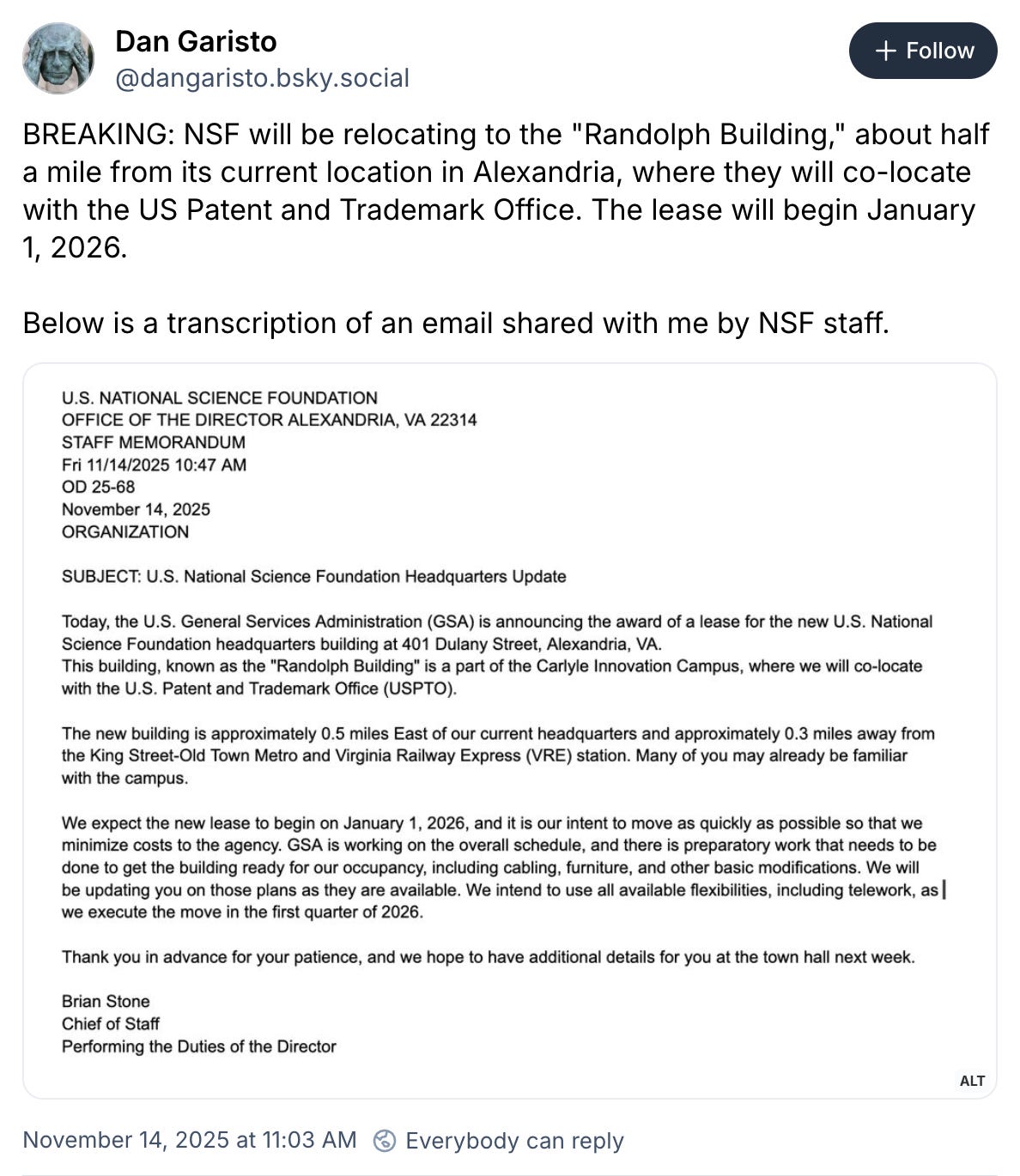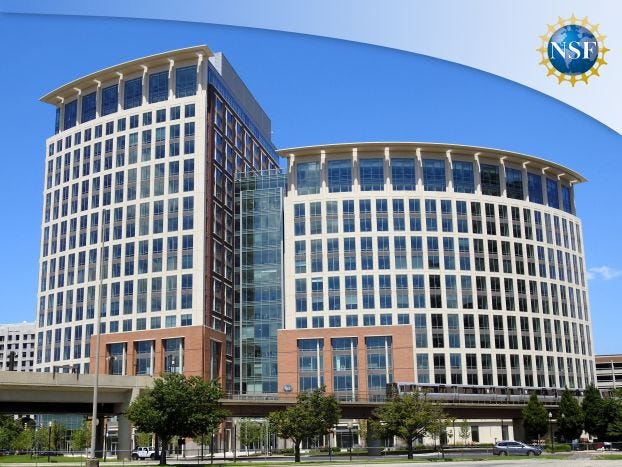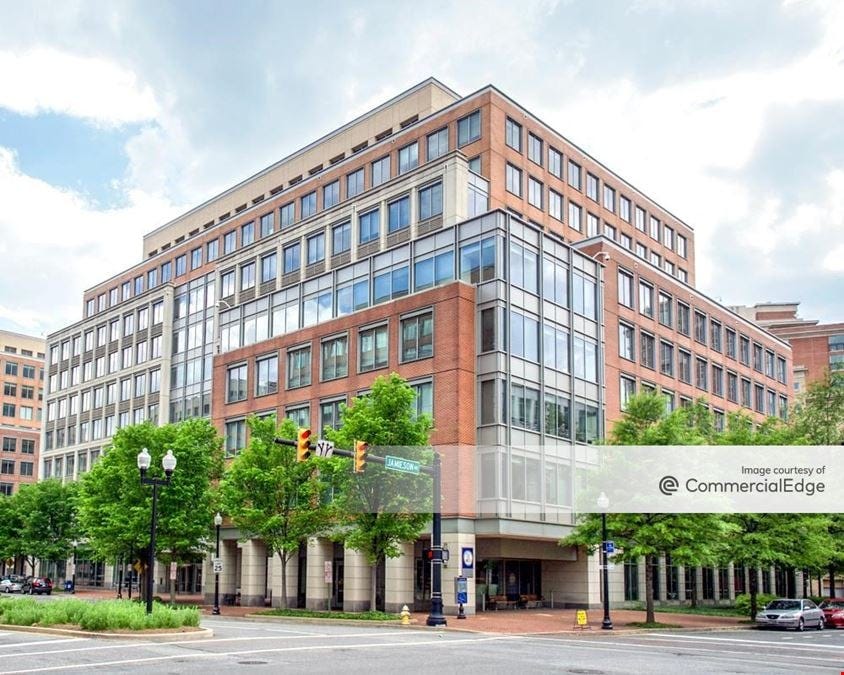National Science Foundation to move to Carlyle Innovation Campus after HUD displacement
Agency will co-locate with USPTO at Randolph Building in early 2026
The U.S. National Science Foundation will relocate to the Randolph Building at 401 Dulany Street in early 2026, nearly five months after the Trump administration announced the agency would be displaced from its Eisenhower Avenue headquarters to make room for the Department of Housing and Urban Development.
The General Services Administration announced the lease award Friday morning, according to an internal staff memorandum obtained by The Alexandria Brief. The move confirms what federal real estate experts predicted in August: that NSF would backfill space recently vacated by the U.S. Patent and Trademark Office in one of two LCOR Inc.-owned buildings on Dulany Street.
The new headquarters, part of the Carlyle Innovation Campus, sits approximately half a mile east of NSF’s current location at 2415 Eisenhower Avenue and 0.3 miles from the King Street-Old Town Metro station.
“This building, known as the ‘Randolph Building’ is a part of the Carlyle Innovation Campus, where we will co-locate with the U.S. Patent and Trademark Office (USPTO),” wrote Brian Stone, NSF’s Chief of Staff who is performing the duties of the director, in the internal memo sent to staff at 10:47 a.m. Friday.
The lease is set to begin January 1, 2026, with NSF planning to execute the move during the first quarter of next year. Stone indicated the agency intends to move “as quickly as possible” to minimize costs while GSA completes preparatory work including cabling, furniture installation, and other modifications.
Displacement drama
The relocation concludes a turbulent period for NSF that began June 25, when HUD Secretary Scott Turner, Virginia Gov. Glenn Youngkin, and GSA Commissioner Michael Peters announced at NSF’s headquarters that HUD would take over the building.
Officials at the time emphasized taxpayer savings and improved working conditions for HUD employees, with Peters promising to help NSF identify suitable alternative space while ensuring a smooth transition.
“We’re going to do it as quickly as we can while also doing it in a manner that isn’t disruptive to the current tenants,” Peters said in June.
Alexandria Mayor Alyia Gaskins immediately pledged to keep NSF in the city, saying, “We have a long and significant partnership with NSF and are committed to keeping their home in Alexandria.”
Tight search parameters
GSA launched a formal search in late August for 240,000 to 280,000 square feet of Class A office space, with strict requirements that effectively limited options to Alexandria’s Eisenhower East corridor near Metro.
Perhaps most tellingly, GSA specified that the space must be “contiguous within a single building or in a shared location with a complementary federal agency that can create a high-profile science and innovation hub” - language that appeared to describe the USPTO buildings on Dulany Street.
The 48-month lease term represents an unusually short commitment for a federal agency, designed to keep costs below GSA’s fiscal year 2025 prospectus threshold of $3.926 million and allow for faster procurement without congressional approval.
Transition ahead
NSF will utilize “all available flexibilities, including telework” during the move, according to Friday’s memo. Staff can expect additional details at a town hall meeting scheduled for next week.
The co-location with USPTO creates what GSA envisioned as a “high-profile science and innovation hub” in the Carlyle neighborhood, keeping both agencies within Alexandria’s growing technology corridor.
Stone’s memo notes that “many of you may already be familiar with the campus,” suggesting some NSF employees have previously visited or worked in proximity to the USPTO space.
Science journalist Dan Garisto also obtained a copy of the internal memo and first reported the news on social media Friday morning.

NSF, GSA, and Alexandria Economic Development Partnership (AEDP) have been contacted for comment.



